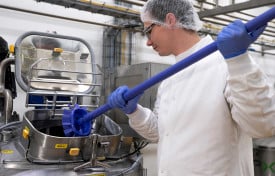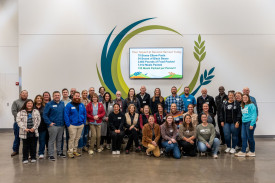Food Safety

- July 02, 2021
Summer is here! What a perfect opportunity to get outside and enjoy the warm summer air we've all been craving! For some individuals, spending time outdoors could involve hiking,
- July 01, 2021
Meet regulatory requirements with accurate temperature readings. Accurate and reliable temperature monitoring is a crucial aspect for the food and dairy industries. Now more than ever, regulatory compliance is of the utmost importance, and having the exact thermometer for your intended application will be the key to success and accountability.
With a variety of monitoring options available, temperature instrumentation is more flexible today than ever before.
With that in mind, Nelson-Jameson has developed a Temperature Monitoring Program, featuring products and information to help you meet regulatory requirements with accurate temperature readings in any application.Below you will find everything from dial and digital thermometers to chart recorders and data loggers to help ensure your food stays safe.
For more information on Thermometers, visit our Learning
- June 07, 2021
An essential part of any robust environmental sampling program is ensuring concise, representative samples. Without ensuring the quality of a sample, one can certainly not ensure the quality of a sampling program, or the quality of one's product.
One of the most popular methods of surface sampling used by our customers in the food industry are sponge samplers for larger areas (swabs being used most often for smaller and harder-to-reach areas). Often composed of cellulose or polyurethane, sponge samplers are everyday essentials for our food industry customers, that help proactively mitigate against environmental contamination concerns. Though a common, daily practice in a food processing facility, it is useful to occasionally revisit sampling techniques to ensure the best representative samples are being taken by employees.
So, if you haven't revisited your sampling best practices lately, here is what the
- April 07, 2021
Ah, the beauty and purity of a new cleaning tool. Freshly removed from any packaging, and unsullied by the elements: nothing but possibility ahead of it. Whether you enjoy opening new tools as much as I apparently do, or you are more in the “pop it open, because there is a ton of stuff to do” camp, there are a few tips that our friends from Remco have provided to get the best out of your new cleaning tool. These simple steps help to ensure safety before the first use.
How to Prepare a New Cleaning Tool for Use
New cleaning tools—especially those sealed in plastic pouches like the ones from Vikan® and Remco—often look like they’re ready for use right out - February 19, 2021
Ten years...that’s a long time, right? But...not really. The more I see 10th, 20th, or 25th-anniversary releases of favorite albums or movies, the more I feel like time is slipping away...and ten years seems more like a blink. So, when you consider the dichotomy of the slow and all-too-quick hands of time, it’s impressive how much has been accomplished, and yet how far we have to go in food safety since the Food Safety Modernization Act was enacted in early 2011.
As much as it would be great to go with either a “yay” or “nay” as to whether it has been a success, like many pieces of major legislation, there have been both phenomenal strides as well as stagnation. As food safety is a complex undertaking, involving waves of domestic and global political and trade relations, budgetary concerns, etc., the quality assurance of the Act itself can be a challenge at times. As we’ll see though, overwhelmingly,
- November 09, 2020
According to the FDA, "one of the most commonly documented food safety problems in plants have involved sanitation monitoring, including checking food-contact surfaces and plant cleanliness" (Schug, para. 1). To make matters even more complicated, the
COVID-19 pandemic disrupted normal operations as well for countless food and beverage manufacturers. Disruptions may occur due to limited staff because of layoffs, social distancing requirements, or sickness. These situations on top of the normal expectations of having a clean food plant, can lead to the need of resources for food safety sanitation.It is essential that food manufacturers create safe, quality food, therefore, routine practices need to continue, and additional sanitation protocols may need to be added. Employers also need to ensure a safe environment for their staff, including minimizing the risk of being exposed
- October 30, 2020
Significantly minimize food vulnerabilities with Nelson-Jameson's food defense product solutions! According to the FDA, food defense is defined as, "the effort to protect food from acts of intentional adulteration" (Food Defense, 2020, para. 1). Intentional adulteration could include various contaminations that are intended to cause harm to the public. In order to prevent and protect from harmful contamination, a food defense plan needs to be established. A food defense plan first consists of your facility completing a vulnerability assessment. This assessment is to determine where in the facility's processes pose the greatest risk for contamination. Second, mitigation strategies need to be selected for identified vulnerabilities, and lastly, corrective action needs to be implemented. Nelson-Jameson has products that are designed to assist with mitigation and preventative strategies within your facility and aid in your food defense plan:
• Use color-coded personnel identification
- September 28, 2020
September is Food Safety Education Month! According to the FDA, the importance of food safety is learning and educating others on taking an active role in preventing foodborne
- September 14, 2020
Forty years ago, DSM introduced Delvotest®, an easy to use, reliable, antibiotic residue test for farmers, dairies, and milk control laboratories. Today, Delvotest® is the gold standard for antibiotic residue testing in the global dairy industry, since it provides the confidence to meet increasingly stringent global legislation and quality demands.
When it comes to individuals daily food consumption, the last thing we seem to worry about is the presence of antibiotic residue in our meats or dairy products. But if a dairy cow had an antibiotic in its system that was designed to fight off a bacterial infection, the residue from the antibiotic could easily be carried over to the milk the cow produced, which is not good. If the entire tank truck of milk was contaminated with antibiotics, the whole thing must be discarded per the FDA.
- June 23, 2020
A critical component in food safety is the detection of contaminants. One of the worst nightmares of anyone working in food processing, is finding something in the final product that is not supposed to be there. This can cause costly product loss, clean-up and maintenance costs, and the potential for recalls and/or litigation. Even though everyone tries to prevent foreign object contamination, pieces of tools such as scrapers can break off, or items such as pens can fall into the product. To make sure that these items are caught, and that contaminated product does not make it out the door, many plants utilize metal detection devices and products.
Metal detectable products are constructed of a few different materials. They are often blue for easy visual detection. Blue is also the most common non-food color.







